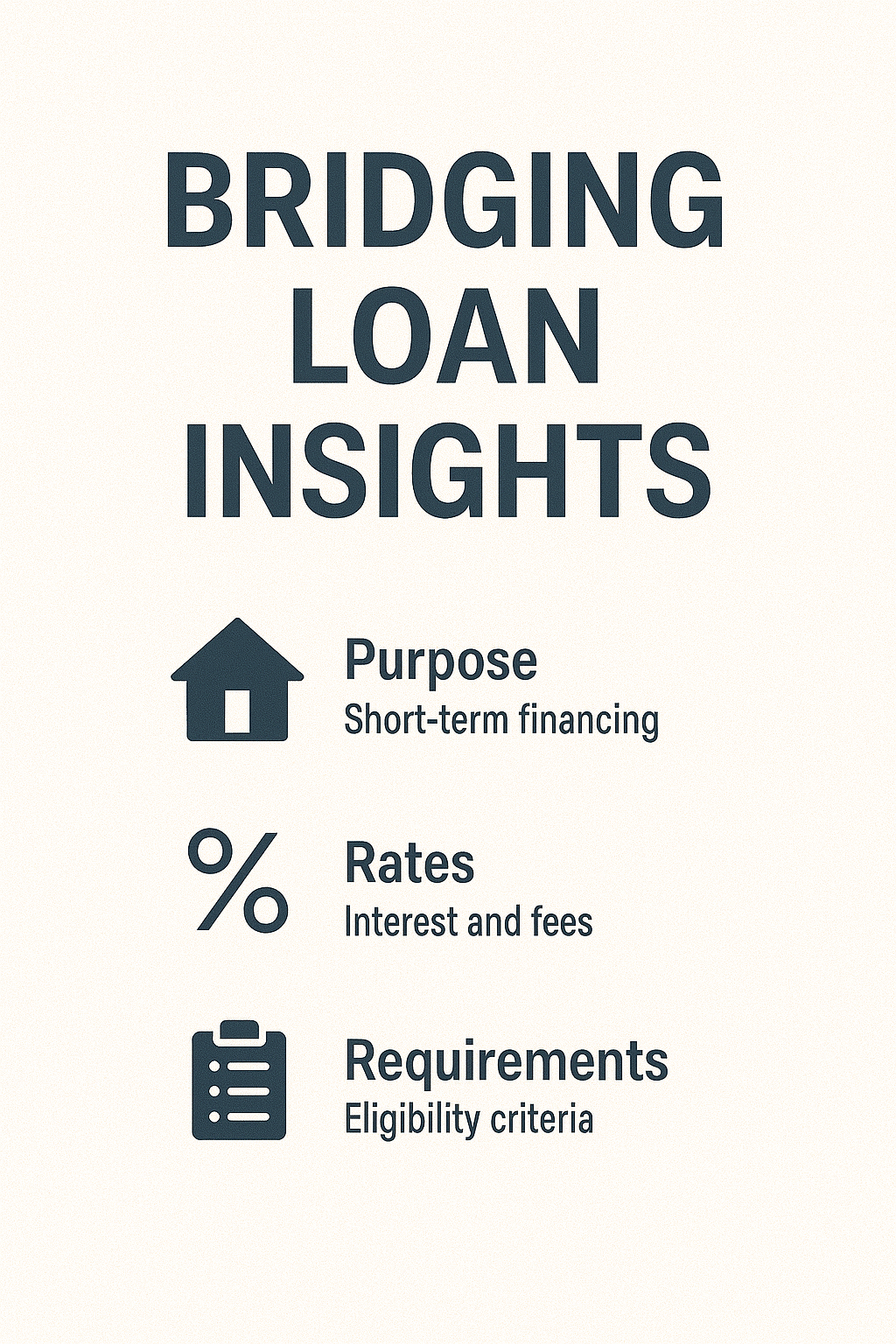In the fast-paced world of business, securing timely and effective financial solutions is crucial for success, especially for small to medium-sized enterprises. Business bridging loans have emerged as a vital tool for entrepreneurs in Australia, offering a flexible and efficient way to manage cash flow and seize new opportunities.
Whether you’re looking to cover a gap between major transactions or need short-term financing to expand your operations, understanding the nuances of commercial loans can empower your business to thrive.
In this post, we’ll dive into how bridging loans can serve as a strategic asset, providing you with the confidence and resources needed to propel your business forward. Join us as we explore the best options tailored to the unique needs of Australian business owners.
Understanding Bridging Loans
Bridging loans are a crucial financial tool for businesses in Australia. Let’s explore what they are, their key features, and how they function as short-term financing solutions.
What Are Bridging Loans?
Bridging loans are short-term financial solutions designed to “bridge” the gap between immediate funding needs and long-term financing. These loans provide businesses with quick access to capital, typically for a period of 6 to 18 months.
In the Australian business landscape, bridging loans serve as a vital resource for companies facing temporary cash flow challenges or seeking to capitalize on time-sensitive opportunities. They offer a flexible alternative to traditional bank loans, often with faster approval processes.
Key characteristics of bridging loans include higher interest rates compared to long-term financing, but with the benefit of rapid fund disbursement. This makes them ideal for scenarios such as property acquisitions, business expansions, or covering operational costs during transitional periods.

Key Features of Business Loans
Business loans in Australia come with distinct features tailored to meet the diverse needs of enterprises. Understanding these characteristics is crucial for making informed financial decisions.
Loan Amount: Business loans can range from small sums to substantial capital, typically based on the company’s financial health and collateral.
Interest Rates: These vary widely, often higher than personal loans due to increased risk. Rates can be fixed or variable, impacting repayment predictability.
Repayment Terms: Flexibility is key, with options including monthly installments, balloon payments, or interest-only periods.
Collateral Requirements: Secured loans often offer better rates but require assets as security. Unsecured options are available but may have stricter eligibility criteria.
Short-Term Financing Explained
Short-term financing is a critical component of business financial management, offering quick solutions to immediate cash flow needs. This type of funding is typically used for periods of less than a year, making it ideal for bridging temporary gaps or seizing short-lived opportunities.
Key characteristics of short-term financing include:
-
Rapid approval and fund disbursement
-
Higher interest rates compared to long-term loans
-
Flexible repayment options
Short-term loans can take various forms, such as lines of credit, invoice financing, or merchant cash advances. Each option has its unique features, suited to different business scenarios.
For Australian businesses, short-term financing can be a lifeline during seasonal fluctuations, unexpected expenses, or when awaiting payments from clients. It provides the agility needed to maintain operations and growth momentum without long-term financial commitments.
Benefits of Bridging Loans
Bridging loans offer unique advantages for businesses in Australia, providing financial solutions for growth, flexibility in commercial lending, and quick access to funds when needed most.
Financial Solutions for Growth
Bridging loans serve as powerful financial solutions for businesses aiming to accelerate growth. These short-term financing options can be instrumental in seizing time-sensitive opportunities that traditional loans might miss due to lengthy approval processes.
For instance, a retail business looking to expand its operations by acquiring a prime location can use a bridging loan to secure the property quickly. This agility can be the difference between capitalizing on a market opportunity and missing out to competitors.
Moreover, bridging loans can help businesses manage cash flow during periods of rapid expansion. They provide the necessary capital to cover increased operational costs, inventory purchases, or hiring new staff before the returns from growth initiatives are realized.
Key growth scenarios where bridging loans excel:
-
Funding business acquisitions
-
Supporting rapid market expansion
-
Financing inventory for large orders
-
Covering costs during seasonal peaks
Flexibility in Commercial Loans
Commercial bridging loans offer unparalleled flexibility, adapting to the diverse and often unpredictable needs of businesses in Australia. This flexibility is a key advantage in today’s fast-paced business environment.
Customizable Terms: Lenders often tailor repayment schedules and loan structures to fit specific business needs. This can include interest-only periods or balloon payments at the end of the term.
Varied Use of Funds: Unlike some traditional loans with strict usage criteria, bridging loans often allow businesses to allocate funds as needed. This could range from property purchases to equipment acquisition or even debt consolidation.
Speed of Approval: The flexible nature of bridging loans often translates to quicker approval processes. This is crucial for businesses needing to act swiftly on opportunities or address urgent financial needs.
Quick Access to Funds
One of the most significant advantages of bridging loans is the speed at which businesses can access funds. This rapid availability can be crucial in time-sensitive situations or when unexpected opportunities arise.
Streamlined Application Process: Many bridging loan providers in Australia have simplified their application procedures, often allowing online submissions and quick document verification.
Faster Approval Times: Compared to traditional bank loans, bridging loans typically have shorter approval times. This can range from a few days to a couple of weeks, depending on the complexity of the application.
Immediate Fund Disbursement: Once approved, funds are usually made available quickly, sometimes within 24 to 48 hours. This rapid access can be pivotal in scenarios like:
-
Securing a time-limited business opportunity
-
Addressing urgent cash flow gaps
-
Meeting unexpected financial obligations
Choosing the Right Loan for Your Business
Selecting the appropriate bridging loan is crucial for your business’s financial health. This process involves carefully evaluating your needs, comparing available options, and choosing a reliable loan provider.
Evaluating Your Business Needs
Before diving into the world of bridging loans, it’s essential to conduct a thorough assessment of your business’s financial requirements. This evaluation will help you determine the most suitable loan type and terms for your situation.
Start by clearly defining the purpose of the loan. Are you looking to bridge a gap in cash flow, fund a time-sensitive opportunity, or finance a short-term project? Understanding your specific needs will guide your decision-making process.
Next, consider your business’s financial health and repayment capacity. Analyze your cash flow projections, current debts, and potential revenue streams. This will help you determine a realistic loan amount and repayment term that won’t strain your finances.
Key factors to consider:
-
Loan amount required
-
Desired repayment period
-
Your business’s credit score and financial history
-
Available collateral (if opting for a secured loan)
Comparing Financial Solutions
When exploring bridging loan options in Australia, it’s crucial to compare various financial solutions to find the best fit for your business. This comparison should go beyond just interest rates and look at the overall package each lender offers.
Interest Rates and Fees: While bridging loans typically have higher interest rates than traditional loans, they can vary significantly between lenders. Compare not just the headline rate but also any additional fees such as establishment costs, ongoing charges, and early repayment penalties.
Loan Terms and Flexibility: Assess the flexibility of each loan option. Look for features like the ability to make extra repayments, redraw facilities, or the option to convert to a long-term loan if needed.
Loan-to-Value Ratio (LVR): For secured bridging loans, compare the maximum LVR offered by different lenders. A higher LVR might mean you can borrow more, but it also increases your risk.
Selecting the Best Loan Provider
Choosing the right loan provider is as crucial as selecting the loan itself. The lender you partner with can significantly impact your borrowing experience and the overall success of your financial strategy.
Reputation and Experience: Research the lender’s track record in the Australian market. Look for providers with a strong reputation in business lending, particularly in your industry sector. Customer reviews and testimonials can offer valuable insights.
Regulatory Compliance: Ensure the lender is fully compliant with Australian financial regulations. Check if they’re registered with ASIC (Australian Securities and Investments Commission) and adhere to responsible lending practices.
Customer Service and Support: Consider the level of support offered by the lender. A provider that offers personalized service and guidance throughout the loan process can be invaluable, especially for complex bridging loan arrangements.
• Key factors in selecting a loan provider:
-
Transparency in terms and conditions
-
Flexibility in loan structuring
-
Speed of application processing and fund disbursement
-
Quality of customer support and guidance
How to Apply for Bridging Loans in Australia
Applying for a bridging loan in Australia involves careful preparation, understanding the application process, and knowing how to increase your chances of approval. Let’s break down these crucial steps.
Preparing Essential Documentation
The success of your bridging loan application often hinges on the quality and completeness of your documentation. Preparing these essential documents in advance can significantly streamline the process and improve your chances of approval.
-
Business Financial Statements: Prepare up-to-date profit and loss statements, balance sheets, and cash flow projections. These should typically cover the last two to three financial years.
-
Tax Returns: Both business and personal tax returns for the past two years are usually required.
-
Business Plan: A comprehensive business plan that outlines your company’s strategy, market position, and growth projections can strengthen your application.
Additional documents may include:
-
Proof of identity for all business owners
-
Details of existing loans and liabilities
-
Asset valuations (for secured loans)
-
Bank statements for the past 6-12 months
Navigating the Application Process
The application process for bridging loans in Australia typically involves several key steps. Understanding this process can help you navigate it more efficiently and with less stress.
-
Initial Consultation: Many lenders offer a preliminary discussion to assess your needs and eligibility. Use this opportunity to ask questions and understand the lender’s specific requirements.
-
Formal Application Submission: This involves completing the lender’s application form and submitting all required documentation. Many lenders now offer online application options for convenience.
-
Assessment and Valuation: The lender will review your application and may conduct a valuation of any assets offered as security.
-
Loan Offer: If approved, you’ll receive a formal loan offer detailing the terms and conditions. Review this carefully before accepting.
-
Settlement: Once you accept the offer, the lender will finalize the paperwork and disburse the funds.
Tip: Keep in regular contact with your lender throughout the process to address any queries promptly and avoid delays.
Tips for Successful Loan Approval
Increasing your chances of bridging loan approval requires strategic preparation and presentation of your business case. Here are some key tips to enhance your application:
Strong Business Case: Clearly articulate why you need the loan and how it will benefit your business. Provide a detailed plan for how you’ll use the funds and repay the loan.
Improve Your Credit Score: Before applying, check your business and personal credit scores. Take steps to improve them if necessary, such as paying down existing debts or correcting any errors in your credit report.
Demonstrate Repayment Capacity: Show clear evidence of how you’ll repay the loan. This could include projected cash flows, confirmed future contracts, or pending property sales.
• Additional tips for success:
-
Be transparent about your financial situation
-
Have a clear exit strategy for the loan
-
Consider offering additional security if possible
-
Prepare for questions about your business and financials
Real-Life Success Stories
Real-world examples of businesses benefiting from bridging loans can provide valuable insights and inspiration. Let’s explore how these financial solutions have empowered small businesses, transformed entrepreneurial dreams, and helped achieve financial stability.
Empowering Small Businesses
Bridging loans have played a crucial role in empowering small businesses across Australia, providing the financial leverage needed to overcome challenges and seize opportunities. These success stories demonstrate the transformative power of timely financing.
Case Study: Local Retailer Expansion
A family-owned clothing store in Melbourne used a bridging loan to fund a rapid expansion opportunity. The loan allowed them to secure a prime location in a popular shopping center, significantly increasing their customer base.
Key Outcomes:
-
40% increase in annual revenue within the first year
-
Successful repayment of the loan in 9 months
-
Establishment of a strong presence in a new market segment
This example highlights how bridging loans can provide the agility small businesses need to capitalize on growth opportunities that might otherwise be out of reach.
Transforming Entrepreneurial Dreams
Entrepreneurs often face financial hurdles when trying to turn their innovative ideas into reality. Bridging loans have proven to be a valuable tool in bridging the gap between vision and execution.
Tech Startup Success Story
A Sydney-based tech startup used a bridging loan to fund the final stages of product development and initial marketing efforts. This timely injection of capital allowed them to launch their product ahead of competitors and secure a significant market share.
Impact on the Business:
-
Successful product launch three months ahead of schedule
-
Attracted venture capital funding within six months of launch
-
Achieved break-even point faster than projected
This case demonstrates how bridging loans can provide critical support at pivotal moments in an entrepreneurial journey, enabling startups to maintain momentum and achieve their goals.
Achieving Financial Stability
Bridging loans have also played a crucial role in helping businesses achieve and maintain financial stability, especially during challenging economic periods or transitional phases.
Manufacturing Company Turnaround
A medium-sized manufacturing company in Brisbane used a bridging loan to restructure its debt and streamline operations during a period of market volatility. This strategic move allowed the company to stabilize its finances and position itself for future growth.
Key Financial Improvements:
-
Reduced overall debt burden by 30%
-
Improved cash flow management
-
Increased operational efficiency, leading to 15% cost reduction
• Lessons from this success story:
-
Bridging loans can be effective tools for financial restructuring
-
Strategic use of short-term financing can lead to long-term stability
-
Timely financial interventions can prevent more serious financial challenges
These real-life examples illustrate the diverse ways in which bridging loans can support businesses across various stages and scenarios, from fueling growth to ensuring survival and stability.




